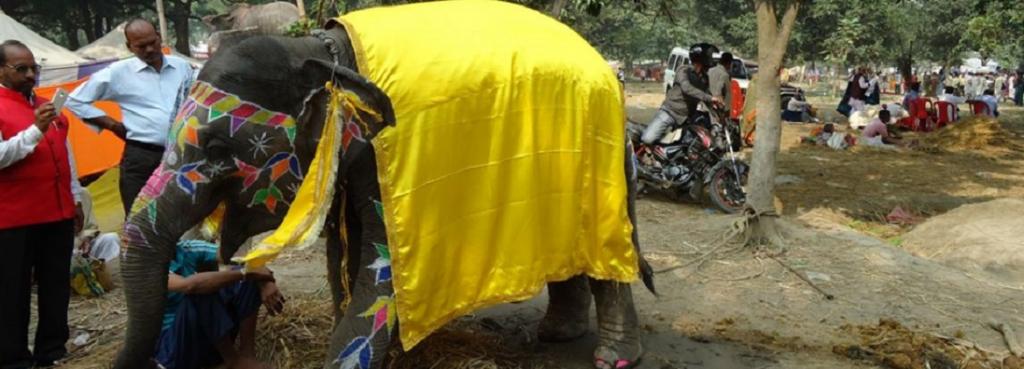

The elephant is India’s National Heritage Animal and displaying it at Sonepur only encourages the brutal and illegal trade in wild elephants across India



I was alarmed to read a report in the New Indian Express dated November 6, 2019, stating ‘Panel formed to ensure jumbos turn up at Bihar's famous Sonepur fair.’
This was an extremely worrisome development given that different animal rights groups including the one I work for, World Animal Protection (WAP), have worked for years to prevent the display and sale of elephants at Sonepur.
My fears were realised when news came that the display of elephants at Sonepur had resumed from 11 November 2019.
“This retrogressive action turns the clock back on several years of work to prevent the exploitation of elephants on the fair premises and to put an end to trading in elephants and the infliction of cruelty to sentient animals,” Gajender K Sharma, country director, World Animal Protection India, said.
According to the information available with WAP, 9-12 elephants occupied the Sonepur fair premises this year. The chief wildlife warden put out a notice on November 12, 2019, highlighting illegal wildlife trade and cruelty to animals.
However, the very presence of the live elephants on the fair premises can be perceived as contradictory to the content of the announcement.
Elephants at Sonepur
 An elephant calf being displayed at the Sonepur fair in Bihar. Photo: Shubhobroto Ghosh
An elephant calf being displayed at the Sonepur fair in Bihar. Photo: Shubhobroto Ghosh
Historically, Sonepur has seen a huge congregation of elephants in one place, many of which were traded for zoos, circuses, temples, logging, patrolling and private ownership.
Elephants traded in Sonepur usually landed up all over the country, including Jaipur in Rajasthan where they were/are held in inhospitable conditions and are used to provide joy rides.
With the passage of time and heightened awareness on wildlife protection, this gathering of a species protected under Schedule I of the Wild Life (Protection) Act, 1972 was no longer deemed tenable legally or morally.
The concerted effort by a number of groups led to the cessation of wild animal display in Sonepur for the past two years.
Moreover, the Patna High Court, in Civil Writ Jurisdiction case No.21952 in 2014, had placed a ban on the sale and projection of animals that are not permitted under the law.
There is however, a loophole in the WPA. Traders regularly misuse the exemption to elephants given under Section 40 of the Wild Life (Protection) Act, 1972, to trade in these animals in Sonepur under the pretext of gifting.
Recent reports show an alarming rise in the illegal trade of elephants in India, with more than 300 elephants that remain unaccountable after being taken away from Assam.
It is likely that this clandestine and illegal trade impacts wild elephant populations that are already under duress due to poaching and habitat destruction.
There is a multiplicity of issues surrounding the treatment of elephants in India and the capture and exploitation of elephants in captivity are among the most critical of these.
The government of India had declared the elephant as the National Heritage Animal in 2010 and the management of elephants in captivity has been dealt with duly in the Ministry of Environment and Forests’ own publication on elephants, ‘Gajah : Securing The Future For Elephants in India’.
For too long, wild elephants have had to undergo the cruel ‘crush’ process that bows them to human will and their eventual slavery for human entertainment.
Although some may see the resumption of the elephant display at Sonepur this year as a significant cultural event, it is WAP’s view that cultural events can be organised without dragging in wild animals in abeyance of morality and legality.
We are mindful and respectful of the cultural importance of the Sonepur fair and would encourage the state government and administration to continue the cultural spectacle without indulging in a practice that portrays the wrong message of human dominance over other life forms.
We can only hope that the concerned authorities will not allow the display and sale of live elephants in Sonepur fair again in the future.
Shubhobroto Ghosh is currently Wildlife Projects Manager at World Animal Protection, India. He is a former journalist and author of ‘Dreaming in Calcutta and the Channel Islands’
We are a voice to you; you have been a support to us. Together we build journalism that is independent, credible and fearless. You can further help us by making a donation. This will mean a lot for our ability to bring you news, perspectives and analysis from the ground so that we can make change together.

Comments are moderated and will be published only after the site moderator’s approval. Please use a genuine email ID and provide your name. Selected comments may also be used in the ‘Letters’ section of the Down To Earth print edition.